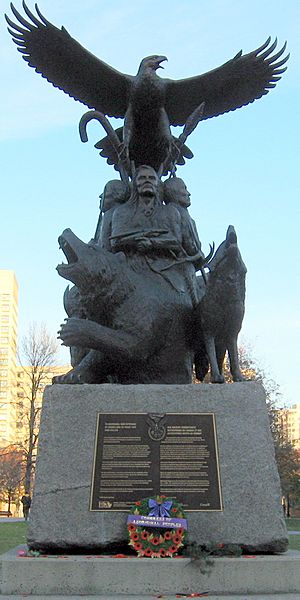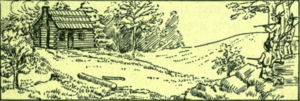Military history of the Maliseet people facts for kids
The Maliseet militia were brave warriors from the Maliseet people in northeastern North America. They teamed up with the Wabanaki Confederacy (especially the Mi'kmaq militia), the French, and the Acadian militia. Together, they fought against the British in six wars over 75 years. They also joined the fight against the British during the American Revolution. Later, after Canada became a country, Mi'kmaq warriors helped Canada in World War I and World War II.
Contents
Early Battles: 16th Century Conflicts
In the 1500s, the Mi'kmaq and Maliseet people faced battles against the Iroquois. These fights show how different Indigenous groups sometimes clashed.
The Battle at Bae de Bic
In the spring of 1534, a big battle happened at Bae de Bic. About 200 Mi'kmaq people were camped on an island in the St. Lawrence River. Suddenly, 100 Iroquois warriors attacked them. The Mi'kmaq knew the Iroquois were coming. They moved about 200 people to a cave on the island for safety.
The Mi'kmaq warriors bravely defended their people. They fought hard, and at first, they pushed the Iroquois back. The Mi'kmaq built a small fort on the island. But the Iroquois came back with flaming arrows. These arrows burned down the fort and defeated the Mi'kmaq.
Fights Along the Bouabouscache River
Before the Bae de Bic battle, Mi'kmaq scouts found where the Iroquois had hidden their supplies. They asked 25 Maliseet warriors for help. The Mi'kmaq and Maliseet militia set a trap for the Iroquois. They attacked the first group of Iroquois, killing ten and wounding five. The Mi'kmaq and Maliseet then safely retreated into the woods.
The Iroquois lost their canoes and supplies. They were forced to walk back to their village. The Mi'kmaq and Maliseet militia chased them for three days. They continued to fight the Iroquois along the way.
The Battle at Riviere Trois Pistoles
Soon after, the Iroquois stopped at the Riviere Trois Pistoles to build new canoes. A hunting party went to find food. But the Mi'kmaq and Maliseet militia found and killed them. The remaining Iroquois were ambushed, and nine more were killed.
The Mi'kmaq and Maliseet then attacked the main Iroquois camp. This was a tough fight. Three Maliseet warriors died, and many others were hurt. But in the end, the Mi'kmaq and Maliseet militia won. They captured the remaining six Iroquois warriors.
King William's War: Late 1600s Conflicts
King William's War (1688–1697) was a major conflict between the French and English. Indigenous groups like the Maliseet and Mi'kmaq often sided with the French.
Siege of Pemaquid (1689)
Maliseet warriors from Fort Meductic helped attack the English fort at Pemaquid. This fort was an important English outpost. A large group of Abenaki and Maliseet warriors surrounded the fort. They captured or killed most of the settlers outside. The small group of soldiers inside had to surrender.
On August 4, 1689, the attackers burned the fort and the nearby town. One of the captives taken by the Maliseet was John Gyles. He was brought back to their village at Meductic on the Saint John River.
Battle of Fort Loyal (1690)
In May 1690, during King William's War, Mi'kmaq and Maliseet warriors from Fort Meductic attacked an English settlement. This settlement was on the Falmouth neck, where Portland, Maine is today. About 400 to 500 French and Indigenous troops attacked the town.
The settlers were greatly outnumbered. They fought for four days before giving up. Sadly, about 200 settlers were killed. After this, authorities decided to destroy the fort and move the people away. This was to prevent another disaster.
Raid on Oyster River (1694)
The Raid on Oyster River happened on July 18, 1694. The French wanted to stop peace talks between the English and the Abenaki tribes. So, a French leader named Claude-Sébastien de Villieu led about 250 Abenaki and Maliseet warriors. A group of Maliseet from Meductic, led by Assacumbuit, joined the attack.
They attacked the English settlement of Oyster River (now Durham, New Hampshire). The attack started at dawn. The small forts there quickly fell. In total, 104 people were killed, and 27 were taken captive. Half the homes were burned, and crops were destroyed. This caused great hardship for the survivors.
Siege of Pemaquid (1696)
New France, led by Pierre Le Moyne d'Iberville, teamed up with Maliseet and Mi'kmaq militias. They fought a naval battle in the Bay of Fundy. After this, they raided Bristol, Maine again. Before the naval battle, 140 Indigenous warriors ambushed English ships. They killed five men who were getting firewood.
Siege of Fort Nashwaak (1696)
Maliseet warriors from Meductic also helped protect the Acadian capital, Fort Nashwaak. This fort is in present-day Fredericton, New Brunswick. Colonel Benjamin Church led 400 New England soldiers to attack the fort.
The siege lasted two days, from October 18–20, 1696. Governor Villebon asked Father Simon-Gérard to gather Maliseet militia from Meductic. On October 16, 36 Maliseet warriors arrived to defend the fort. There was a fierce exchange of gunfire. The New Englanders were defeated, losing eight killed and seventeen wounded. The French lost only one killed and two wounded.
Father Rale's War: Early 1700s Conflicts
Father Rale's War (1722–1725) was a time when the Wabanaki Confederacy fought for their own reasons. They were not just defending French interests. The British built forts on Indigenous lands. For example, they built forts at Canso and along the Kennebec River.
The French also claimed these lands. They built churches in Indigenous villages like Norridgewock and Medoctec. After the war, a treaty was signed in Boston in 1726. Three chiefs and about 26 warriors from Medoctec went to Annapolis Royal in 1728 to agree to this treaty.
King George's War: Mid-1700s Conflicts
During King George's War (1744–1748), the Maliseet and Mi'kmaq sought revenge. An English Ranger named John Gorham had killed Mi'kmaq families. During the Siege of Annapolis Royal (1745), the Mi'kmaq and Maliseet captured William Pote and some of Gorham's Rangers.
Pote was taken to the Maliseet village of Aukpaque. On July 6, 1745, Mi'kmaq from Nova Scotia arrived. They tortured Pote and a Mohawk Ranger named Jacob. This was revenge for the killings by Gorham. A few days later, Pote saw another act of revenge at Meductic.
In 1749, before Father Le Loutre's War began, Maliseet leaders, including the chief of Medoctec, went to Halifax. They renewed their treaty with the British.
French and Indian War: Mid-1700s Changes
By the late 1600s, Meductic had a Jesuit mission. It became part of a French seigneury (a type of land ownership). The mission changed Meductic. By 1760, many Maliseet had moved to other communities, and the village was abandoned.
After the war, Meductic continued to decline. In 1767, a priest wrote that the last Indigenous person at Medoctec had died. He moved the church bell to Aukpaque. The bell eventually ended up at St. Ann's church in Kingsclear, New Brunswick. When the Loyalists arrived in 1783, the chapel and fort were still standing.
American Revolution: Late 1700s Involvement
The Maliseet people played a role in the American Revolution (1775–1783).
The Maugerville Rebellion
In 1776, George Washington asked the Maliseet of the Saint John River for their help. He wanted them to support the Americans against Britain. Led by Chief Ambroise Saint Aubin, the Maliseets immediately began to attack British settlers in Maugerville, New Brunswick. They burned some homes and took people prisoner.
In 1779, Maugerville was raided again by Maliseets working with John Allan. In response, the British built a small fort called Fort Hughes at the mouth of the Oromocto River.
St. John River Expedition
During the St. John River expedition, American Patriot Colonel John Allan worked hard to get the support of the Indigenous people. He spent four weeks at Aukpaque. His efforts were successful. Many Maliseet people left the region to join the American forces at Machias, Maine.
On July 13, 1777, a large group of 400 to 500 Maliseet men, women, and children left Old Fort Meduetic in 128 canoes. They traveled to Machias. They arrived at a very important time for the Americans. They helped defend the post during an attack by Sir George Collier in August. The British caused only minor damage. The Maliseet's help earned them thanks from the Massachusetts council.
Images for kids




